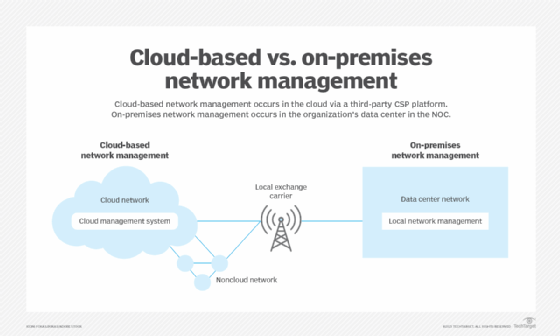Is cloud-based network management right for your business?
Many enterprises use on-premises network management, but some are transitioning to cloud-based management. Enterprises should evaluate both options before deciding which to use.
Traditionally, on-premises data centers hosted network management. This approach still works for many network managers, but the recent transition to cloud-based infrastructures has resulted in a swing to cloud-based network management.
As enterprises consider the switch to cloud, they should examine the pros and cons of both approaches. Teams should also evaluate whether the network management location makes a difference.
On-premises vs. cloud-based network management
Traditional network applications reside on-premises -- usually in data centers that manage wired LANs, wired WANs and wireless networks. Network carriers, including local exchange telephone companies and large nationwide carriers, provide traditional voice and data networks. Each corporate location has a point of presence in the data center or some network connectivity location.
Traditional on-premises networks include the following equipment:
- Cable termination equipment.
- Switches.
- Routers.
- Hubs.
Aside from hardware, data centers also host network applications, including network management tools. Enterprise network management occurs in the network operations center, where network managers and technicians observe network activity. Normal network management tasks include packet routing, bandwidth management and performance troubleshooting.
This article is part of
What is network management?
It might make sense for some enterprises to turn network management over to an experienced third party. Many third-party hosted systems offer network management tools with similar capabilities. Third-party organizations, such as MSPs, can set up platforms that give network professionals control of management activities.
While most network management apps reside in data centers, cloud applications exist in cloud environments. With the increased adoption of cloud-based network infrastructure services, network professionals might prefer to use cloud-based network management resources. These are available from a third-party MSP or cloud service provider (CSP), such as AWS, Google Cloud and Microsoft Azure.

Approaches to cloud-based network management
As with any major technology procurement, senior management should be on board with the network team's decision. When evaluating if cloud-based network management systems are right for an organization, the network team must do the following:
- Perform a network assessment.
- Compare vendor services.
- Analyze proposal reviews.
- Determine the selection.
It's essential that organizations use previous network management data to create the criteria for a new or upgraded approach.
The network team should also carefully factor in the current network infrastructure configuration -- and any potential changes -- to determine the optimal direction. Organizations should contact carriers to discuss rates, performance issues, service changes and other considerations. The network management team should then conduct the following steps:
- Choose which network management arrangement suits the organization.
- Evaluate which features and resources to use to manage the infrastructure.
- Decide which vendor offers the pricing, support, training, warranty, security and user interaction that best suits the organization.
- Evaluate the transition difficulty from one environment to another.
- Determine the transition ROI.
Pros and cons of cloud-based network management
The following considerations, each with its pros and cons, are important when thinking about the switch to cloud-based network management.
Foundational capabilities
Both cloud and on-premises network management services have the same fundamental capabilities, including the following:
- Real-time network monitoring.
- Data gathering.
- Performance management.
- Problem identification.
Network teams must examine these capabilities -- along with many additional features -- to identify potential benefits of cloud-based network management.
Hybrid and multi-cloud infrastructure
An organization might be more inclined to move to cloud network management if it has already committed all or part of its infrastructure to a CSP. An on-premises or MSP-hosted platform might be better for organizations with a blend of cloud and on-premises infrastructure services. It could also be worthwhile for organizations to use more than one CSP.
Selecting one CSP's network management services over another could introduce new and unintended risks. For example, one CSP might have difficulty obtaining network performance data from another CSP.
Cost
On-premises network management systems are typically applications that run on servers, so the effect on data center space is nominal. However, cost can become an important issue. For example, some on-premises apps have a maintenance contract. Any configuration changes, such as updates to newer versions, might have a one-time cost.
By contrast, cloud-based network management pricing could include the following:
- A monthly fee.
- Fees for service changes and other administrative tasks.
- Fees for maintenance and software updates.
Neither approach has significant advantages, but it's important to exercise proper due diligence when deciding which service to use.
Transition
Going from an on-premises to a cloud-based network management system could introduce new challenges, including:
- Migration complications.
- Training and staffing difficulties.
- Security issues.
- The need for service-level agreements.
AI in cloud-based network management
AI is one of the most significant elements of network management and could become its future. Many on-premises and cloud vendors have noted the inclusion of AI capabilities in their recent releases. Teams can use data and AI to identify appropriate services to improve network performance and take network management to the next level.
Editor's note: This article was originally written by Paul Kirvan and updated by TechTarget editors to improve readability.
Paul Kirvan, FBCI, CISA, is an independent consultant and technical writer with more than 35 years of experience in business continuity, disaster recovery, resilience, cybersecurity, GRC, telecom and technical writing.








